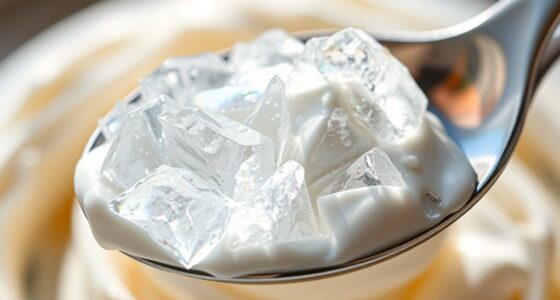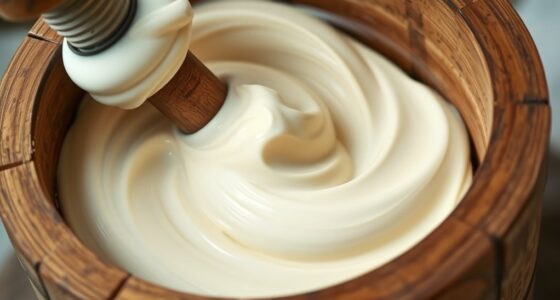Yes, ice cream can taste less sweet when it’s cold because cold temperatures dull your taste buds, making sweetness less noticeable. Warming the ice cream slightly allows your sensory receptors to become more active, revealing richer flavors and a more pronounced sweetness. Additionally, cold can mask subtle notes like vanilla or caramel, which stand out more when the ice cream warms up. If you want to discover how temperature really affects flavor, keep exploring this fascinating connection.
Key Takeaways
- Cold temperatures dull taste buds, making ice cream seem less sweet.
- Warming ice cream enhances flavor perception by increasing sensory receptivity.
- As ice cream warms, nerve endings become more active, revealing richer flavors.
- Cold can mask subtle flavor notes, which become clearer when warmed.
- Allowing ice cream to sit out slightly improves sweetness perception and overall flavor.

The temperature of ice cream considerably influences its flavor and overall taste experience. When you take a scoop straight from the freezer, you might notice it tastes different than when it’s been sitting out for a few minutes. That’s because your flavor perception changes depending on the ice cream’s temperature. Cold temperatures can dull your taste buds, making the sweetness seem less intense. As the ice cream warms, your taste buds become more receptive, revealing richer flavors and a more pronounced sweetness. This is why the same ice cream can seem less sweet when frozen solid but more flavorful as it melts slightly in your mouth.
Ice cream’s flavor deepens as it warms, revealing sweeter, richer tastes beyond its frozen state.
Your sensory adaptation plays a significant role here. When you first bite into very cold ice cream, your taste buds are temporarily less sensitive to certain flavors, especially sweetness. The cold constricts the nerve endings responsible for detecting sugar, so your brain perceives the flavor as milder. As the ice cream begins to melt and warms a little, these nerve endings become more active, and your flavor perception shifts. You’ll notice the ice cream tasting sweeter and more vibrant, even if the actual sugar content stays the same. This sensory adaptation explains why a cold dessert can seem less sweet initially but becomes more appealing as it warms.
It’s also worth noting that the sensation of cold itself can mask other flavor notes. For example, some subtle hints like vanilla, caramel, or fruitiness might be less noticeable when the ice cream is very cold. As it warms, these nuances come to life, enhancing the overall flavor profile. So, if you want to experience the full depth of your favorite ice cream, letting it sit out for a few minutes is often the best move. This not only improves flavor perception but also allows your sensory adaptation to catch up, making the experience more enjoyable.
In essence, the temperature of ice cream doesn’t just affect how cold it feels—it fundamentally alters how you perceive its flavors. Cold constricts your taste buds, dulling sweetness and other flavor nuances, while warming the ice cream revives these sensations. Understanding this relationship can help you optimize your ice cream enjoyment, whether you prefer it straight from the freezer or slightly softened. So next time you’re savoring a scoop, consider how temperature influences what you’re tasting, and maybe give it a moment to warm up for a richer, more satisfying flavor experience.
Frequently Asked Questions
How Does Temperature Affect the Perception of Sweetness in Other Foods?
You might notice that temperature influences how you perceive sweetness in foods. When things are colder, flavor masking can occur, making sweet flavors less intense because your temperature sensitivity diminishes. As foods warm up, your taste buds become more responsive, revealing more of the sweetness. So, temperature plays a key role in how your brain interprets flavors, affecting your overall perception of sweetness in various foods.
Can Serving Ice Cream at Different Temperatures Change Its Overall Flavor Profile?
Serving ice cream at different temperatures can indeed change its overall flavor profile. When you serve it warmer, flavor enhancement occurs, making the taste more pronounced, while the texture variation becomes creamier and softer. Cold ice cream tends to dull flavors slightly but maintains a firmer texture. So, adjusting temperature allows you to explore different sensory experiences, highlighting or mellowing flavors and altering the texture for a more enjoyable treat.
Do Personal Preferences Influence How We Perceive Sweetness at Varying Temperatures?
Your personal taste is like a secret superpower that shapes how you perceive sweetness at different temperatures. When you enjoy ice cream, your flavor perception varies based on your preferences, making some find it sweeter or less sweet regardless of temperature. The cold can dull your taste buds, but your unique palate influences whether you experience a flavor as intensely sweet or subtly muted. It’s all about your taste buds’ incredible sensitivity!
How Quickly Does Ice Cream Change in Taste as It Warms or Cools?
When you warm or cool ice cream, its taste changes quickly. Melting speed affects how fast flavors shift, with warmer temperatures causing it to melt and lose flavor stability rapidly. As ice cream warms, it becomes creamier and its sweetness may seem more intense, but if it cools again, flavors can become muted. You’ll notice these taste changes happen swiftly, especially during temperature fluctuations, impacting your overall enjoyment.
Are There Specific Types of Ice Cream That Taste Sweeter When Cold?
Ironically, you might find some ice creams seem sweeter when cold, even though cold dulls flavor intensity. Certain flavors, like fruit-based or highly sugared varieties, can enhance sweetness perception when chilled because their colder temperature suppresses bitterness and amplifies sugary notes. So, if you prefer a burst of sweetness, try these types cold—you’ll notice their flavor intensity and sweetness perception peak at lower temps.
Conclusion
Remember, the saying “Taste is a matter of perception” holds true. When ice cream is cold, it can seem less sweet because your taste buds are less sensitive at lower temperatures. But as it warms, flavors become more vibrant. So, don’t judge that scoop too quickly—give it a moment to warm up, and you’ll truly appreciate its sweetness. Sometimes, patience reveals the full flavor, proving that good things come to those who wait.









